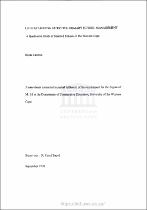| dc.contributor.advisor | Sayed, Yusuf | |
| dc.contributor.author | Laattoe, Bayar | |
| dc.date.accessioned | 2023-02-20T08:05:37Z | |
| dc.date.available | 2023-02-20T08:05:37Z | |
| dc.date.issued | 1998 | |
| dc.identifier.uri | http://hdl.handle.net/11394/9585 | |
| dc.description | Magister Educationis - MEd | en_US |
| dc.description.abstract | The SA Schools Act (1996, p. 2) acknowledges that the past system of education was based on segregation and racial inequality. Prior to 1994, at the national level, the Department of National Education (DNE) was responsible for the general education policy. During this time, the education in the Western Cape for specific racial groups was controlled by the following bodies: 1. Department of Education and Culture (DEC) in House of Assembly (HOA) was responsible for the education of whites; 2. Department of Education and Culture (DEC) in House of Delegates (HOD) saw to the education of Indians; 3. Department of Education and Culture (DEC) in House of Representatives (HOR) was responsible for the education of coloureds; and 4. Department of Education and Training (DET) was responsible for the education of Africans. Although the above bodies have been dissolved, and a single education department has been established, most schools continue to reflect the legacy of the previous system. This can be explained by the fact that the majority of public schools are situated in residential areas which act as feeder areas for the schools, and these areas still reflect the specific population groups for which it was classified. Furthermore, the
teaching staff and the majority of the pupils of the same school are still from the population category though this is starting to change (see Christie,1994). Education for alt children in the Republic of South Africa is compulsory from the age of seven until 15, or the ninth grade, whichever comes first (SA Schools Act, 1996, p.6). This means that the primary education in compulsory. The following study is located within the schools that offer primary education and focuses on the management aspects of four primary schools - one from each of the former racial education departments (see Chapter 4 for more details). During the late 1970's and early 1980's, for example, two of the principals (where the researcher taught) were perceived to be authoritarian, and strict regimented procedures were followed - activities were done according to 'the book' and school inspectors ensured that the department's policies were strictly adhered to. During the middle and late 1980's, the (third) principal - a contemporary of the first two - was perceived as less autocratic and semi-participatory. By the 1990's,
more teachers were becoming unionised and more assertive, and the next (fourth) principal were far more consultative and participatory. School inspectors were renamed 'circuit managers' and their role had changed to giving guidance and advice rather than inspection. | en_US |
| dc.language.iso | en | en_US |
| dc.publisher | University of the Western Cape | en_US |
| dc.subject | Department of National Education (DNE) | en_US |
| dc.subject | Department of Education and Culture (DEC) | en_US |
| dc.subject | House of Assembly (HOA) | en_US |
| dc.subject | House of Delegates (HOD) | en_US |
| dc.subject | Department of Education and Training (DET) | en_US |
| dc.subject | Parent - Teacher Student Association (PTSA) | en_US |
| dc.subject | Western Cape Educational Department (WCED) | en_US |
| dc.title | Understanding effective primary school management: A Qualitative Study of Selected Schools in the Western Cape | en_US |
| dc.rights.holder | University of the Western Cape | en_US |

